| Construction Rating: | starstarstarstar_borderstar_border |
| Flight Rating: | starstarstarstarstar_border |
| Overall Rating: | starstarstarstarstar_border |
| Manufacturer: | Semroc  |
Brief:
This is Semroc's retro-repro of the 1971 Centuri KC-17 Shuttle. The Centuri kit was itself a bit of a copy of the
Estes Orbital Transport.
The shuttle is a parasite glider that separates at ejection, while the main body descends under chute.
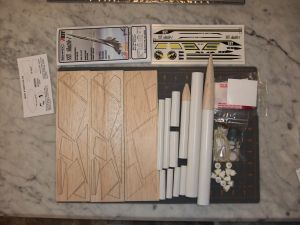
Construction:
This is an xKit, meaning it's basically a bag of parts without instructions though the instructions are archived on
Jim Zalewski's website (with the URL included in the kit documentation). You get quite a pile of parts for this one:
- 1 Body Tube ST-10 10.5" (carrier upper body)
- 1 Body Tube ST-10 8" (carrier lower body)
- 4 Body Tubes ST-5 2.5" (carrier ramjet tubes)
- 2 Body Tubes ST-5 6" (carrier ramjets/wing supports)
- 1 Body Tube ST-7 3" (shuttle mounting tube)
- 1 Body Tube ST-7 3" (18mm motor tube)
- 1 Body Tube ST-7 5" (shuttle body tube)
- 1 Balsa Nose Cone BC-1050 (carrier)
- 1 Balsa Nose Cone BC-715 (shuttle)
- 1 Plastic Nose Cone Set PC-5RJ-2 (ramjets, nozzles)
- 1 Tubing Coupler HTC-10
- 1 Tubing Coupler HTC-7
- 1 Fiber Disc
- 1 Thrust Ring
- 2 Launch Lugs
- 1 Screw Eye
- Elastic/Kevlar® Cord
- 2 Centering Rings CR-710
- 1 Engine Hook
- Laser Cut Fins
- Waterslide Decal
- 2 Plastic Parachute 12"
- Shroud and Canopy Sheet/cardstock
- 2 Washer Weights
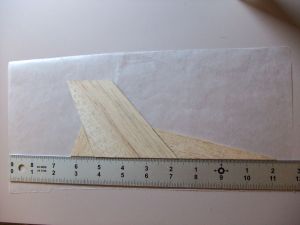
Since this is an xKit, for instructions you get to go online and use the original Centuri instructions from 1971. By 1971 standards, they were probably pretty good but by today's, they would be considered average at best--basic illustrations, some general direction rather than specifics, and it would really benefit from a decent tube marking guide up front, rather than the locate-as-you-go approach.
There are a few deviations from the Centuri instructions that are pointed out in the Semroc printed material with the kit, mainly related to minor part changes made from the original such as using Kevlar®/elastic shock cord and a balsa nose cone on the shuttle.
Overall, I would rate this about a skill level 3, and it's a relatively ambitious construction project, essentially comprised of a complex carrier rocket and a shuttle glider.
The motor mount is straightforward with a metal hook, thrust ring, motor tube, and pair of centering rings. The Kevlar® shock cord is anchored around the metal hook. The completed assembly goes into the 10.5" long tube, although it's recessed by 3/4" to allow enough play on the hook to remove a motor. Personally, I'd rather do without the hook and slip a boat tail in there.
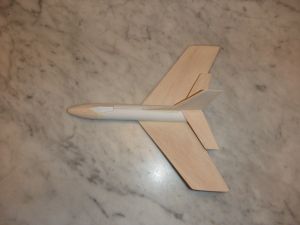
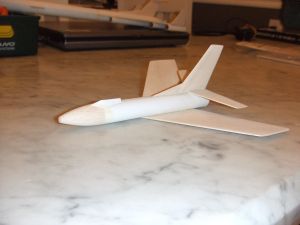
Wing/fin assembly is a fair amount of work, and you'll want to carefully review which piece is which before beginning. The Semroc laser-cut parts are accurately dimensioned, but they are nested differently on the sheet, and two of the parts include a spare.
The carrier wing assemblies are 3-piece, and the fit was excellent. I tacked them with CA rather than the usual wood glue, as I was trying to build this as a filler-work job and had only small pockets of time to devote to it. Prior to bonding the wings, a pair of 6" long body tubes are mounted along the side of the main body tube. The wings rest on top of these tubes, and are supported square to the body tube by using pod tubes at the wing tips for support. This is when I first started thinking a wraparound tube marking guide would be in order as the wings are really just mounted at 180-degree opposite orientation. Later on, various pieces will be mounted 90 degress up and 90 down from these wings so a simple 4-fin alignment guide would have worked fine. Positioning of the wings was not specified, so I went with the aft edge aligned with the aft end of the body tube.
The rudder is a 2-piece assembly and goes on the top of the carrier. A 2-piece tail assembly caps the rudder. Wing tips and canards go on last.
On the underside of the wings, there are 4 short BT-5 tubes that are supposed to be spaced using 1-1/4" spacing between centers. I found this spacing was not quite large enough, as the outside tubes were almost 1/4" away from the edge of the wing. I mounted mine on 1-3/8" spacing. The outer tubes are longer than the span at that end of the wing, so I decided to mount them roughly centered for/aft (with the instructions not offering much guidance here).
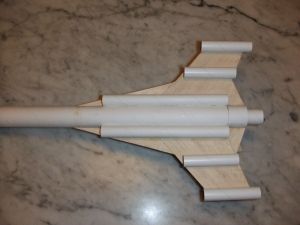
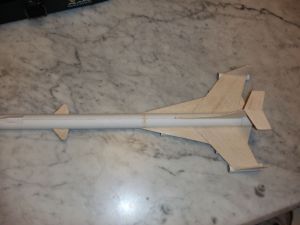
The glider construction is a bit easier although it shares many of the same basic steps. First, the rudder is another 2-piece fin assembly. The wings are also 2-piece but don't allow the glue to set--they are mounted draped over the body tube with the tips touching the table to create a dihedral.
The rudder then goes on the top of the glider body tube (another case where pre-marking might be a good idea rather than trying to eyeball the "top" of the body tube). A pair of tails are then mounted perpendicular to the rudder. The nose cone is glued in place. Another cardstock canopy goes on the shuttle, completing the assembly.
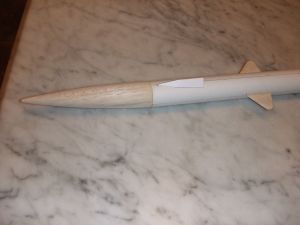 The last portion of assembly is for what is described as a "rocket tube"
assembly. Begin by forming a small shroud, and mounting on a cardboard disk. The Centuri instructions indicate that the
disk/shroud is mounted slightly recessed into the body tube, but my disk was a bit larger OD than the tube. I then
glued on a couple balsa standoffs and a pair of supporting tubes, which are actually 3/16" lugs, one of which
serves as the launch lug. The front of this assembly gets a tube coupler. The shuttle is supposed to slide on and off
easily in order to deploy at ejection, but the coupler is way too tight and needed to be sanded down quite a bit.
The last portion of assembly is for what is described as a "rocket tube"
assembly. Begin by forming a small shroud, and mounting on a cardboard disk. The Centuri instructions indicate that the
disk/shroud is mounted slightly recessed into the body tube, but my disk was a bit larger OD than the tube. I then
glued on a couple balsa standoffs and a pair of supporting tubes, which are actually 3/16" lugs, one of which
serves as the launch lug. The front of this assembly gets a tube coupler. The shuttle is supposed to slide on and off
easily in order to deploy at ejection, but the coupler is way too tight and needed to be sanded down quite a bit.
Other than making a couple 12" plastic chutes, that essentially completes the construction.
Finishing:
For finishing, I skipped the usual grain and spiral filling, opting to shave a little weight. I went with a light
starter coat of white primer followed by two coats of gloss white. Before painting, make sure the coupler is masked, as
this has to be a smooth, loose fit with the shuttle.
The overall paint job was OK although it was a little sloppy in some tough to paint corners, such as in the seams under the various pods.
 I followed up with hand painting the ramjet pieces silver then applying the various decals
per the placement guide from the original instructions.
I followed up with hand painting the ramjet pieces silver then applying the various decals
per the placement guide from the original instructions.
Once I got to the pad, I discovered one significant error and am not sure if it was on my part or on the design itself. The "rocket tube" used to mount the shuttle had a couple of balsa pieces serving as a standoff. The shuttle has wings mounted on the bottom of the body tube, angled upwards for the dihedral. The launch lugs go in the tube/standoff seam. For me, each lug was obstructed by a shuttle wing and no jiggling would work. I wound up having to scrub the planned first launch, and at home I removed the tube, added a third standoff from scrap balsa, and took it back out at our next launch. I am not certain if there is a proper orientation for the standoffs--maybe the "height" and "width" are just enough different that if I'd mounted them turned 90 degrees I'd have just cleared the wing, but they looked roughly square and I needed a full 3/32" extra balsa for clearance.
Construction Rating: 3 out of 5
Flight:
Running out of time to get the review in before the hit list deadline, I wound up having to fly in pretty strong
winds--steady 12-14mph, gusting to 20mph--not exactly ideal conditions.
Given the wind, I went with the lower end of recommended motors and plugged in a B4-2. Boost was impressive--the wind didn't seem to bother it, and it climbed straight with just a little roll. The altitude was pretty weak--I'd estimate it at not quite 100 feet. Ejection was a bit early, still climbing bust not enough to go for a -4.
The glider didn't like the wind one bit and came down in a steep nose-dive. Hand tossing previously had shown some tendency to pitch down but not extreme.
Recovery:
I forgot about the second chute and in prepping this just went with one 12" plastic chute. Big mistake. It came
down pretty fast, and the wind had it whipping along horizontally as well, so on impact I broke loose one of the pods
and even managed to trash a rolled nacelle. That second chute is a clear requirement.
Flight Rating: 4 out of 5
Summary:
The pros on this are the very cool overall design and the impressive cast details. Those help create a beautiful
looking rocket/glider.
My only con would be the lack of tube marking pattern, which is a fault going back to the original design.
Overall Rating: 4 out of 5
Other Reviews
- Semroc cc: SST Shuttle-1 By Drew Tomko
Brief: A "carbon copy" of a Centuri classic by Semroc. The long booster loaded with "ramjets" releases a very cool looking glider at ejection and returns via 2 12" parachutes. Semroc provides all the parts including beautiful resin ramjet cones, laser cut fins, and decals. Instructions are not included but may be downloaded off the Internet. Construction: ...
 |
 |
Flights
 |
 |